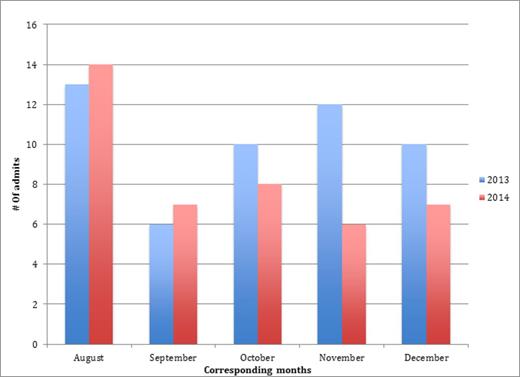Abstract
INTRODUCTION:
Cancer patients with venous thromboembolism (VTE) have threefold increase in all cause hospitalization and days of hospitalization than cancer patients without VTE. Hospitalization with VTE is also associated with higher overall all cause inpatient cost (PMID 23430767). We hypothesized that a centralized cancer-associated thrombosis clinic instituted at the Cleveland Clinic in August 2014 would reduce hospital admissions for this indication and impact the cost of healthcare.
METHODS:
The study population comprised two cohorts: cancer patients admitted with a new diagnosis of VTE to the Cleveland Clinic Main Campus between August 1 and December 31 in 2013 before initiation of the cancer-associated thrombosis (CAT) clinic and between August 1 and December 31 in 2014 after initiation of CAT clinic. Patients who were accepted as transfers from outside hospitals were excluded from the study.
RESULTS:
In the pre CAT clinic study period, there were 101 admissions. Of these, 51 (50%) were admitted primarily for a thromboembolic event whereas the rest had VTE as a secondary diagnosis. In the post CAT clinic study period, there were 94 admissions. Of these, 42 (44.7%) were admitted primarily for a thromboembolic event. The baseline characteristics of the two study groups are detailed in table 1.
There was a reduction in hospital admissions for VTE by 9 admissions in the post CAT clinic period (RR 0.89, RRR 11%, p 0.252). The median length of hospital stay per patient was 3 days, reducing the total days of hospitalization by 27 days in post CAT clinic period. Figure 1
CONCLUSION:
We demonstrated that a centralized CAT clinic can reduce but not eliminate admissions for VTE. Larger health care systems should consider the development of such a service for the management of VTE in cancer patients as it can lead to significant cost savings and reduce unnecessary exposure of this vulnerable patient population to hospital environment
| Characteristic . | Pre CAT clinic period (N) . | Post CAT clinic period (N) . |
|---|---|---|
| Patients admitted with VTE as primary diagnosis | 51 | 42 |
| Median age (years) | 62.41±12.85 | 61.6±13.4 |
| Female patients | 22 (44%) | 26 (39%) |
| Solid tumor diagnosis | 42 (82.4%) | 36 (70.6%) |
| Hematological malignancy | 9 (17.6%) | 6 (11.8%) |
| DVT | 16 (31.4%) | 12 (28.6%) |
| PE | 35 (68.6%) | 30 (71.4%) |
| PE patients with high PESI score (Class III/IV) | 33 (94%) | 28 (93%) |
| Median length of hospital stay (days) | 3 (1-27) | 2.5(1-16) |
| Characteristic . | Pre CAT clinic period (N) . | Post CAT clinic period (N) . |
|---|---|---|
| Patients admitted with VTE as primary diagnosis | 51 | 42 |
| Median age (years) | 62.41±12.85 | 61.6±13.4 |
| Female patients | 22 (44%) | 26 (39%) |
| Solid tumor diagnosis | 42 (82.4%) | 36 (70.6%) |
| Hematological malignancy | 9 (17.6%) | 6 (11.8%) |
| DVT | 16 (31.4%) | 12 (28.6%) |
| PE | 35 (68.6%) | 30 (71.4%) |
| PE patients with high PESI score (Class III/IV) | 33 (94%) | 28 (93%) |
| Median length of hospital stay (days) | 3 (1-27) | 2.5(1-16) |
Khorana:Pfizer: Consultancy, Honoraria; sanofi: Consultancy, Honoraria; Leo Pharma: Consultancy, Honoraria, Membership on an entity's Board of Directors or advisory committees; Janssen: Consultancy, Honoraria, Membership on an entity's Board of Directors or advisory committees; Boehringer-Ingelheim: Consultancy, Honoraria; Daiichi Sankyo: Consultancy, Honoraria. McCrae:Janssen Scientific Affairs: Membership on an entity's Board of Directors or advisory committees.
Author notes
Asterisk with author names denotes non-ASH members.


This feature is available to Subscribers Only
Sign In or Create an Account Close Modal